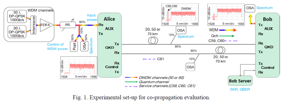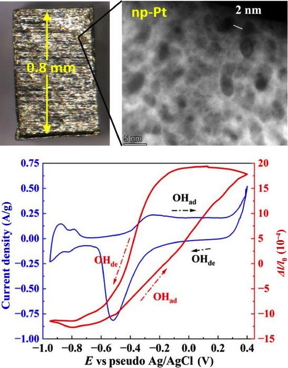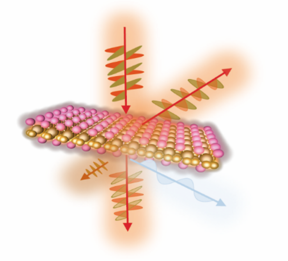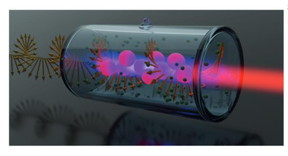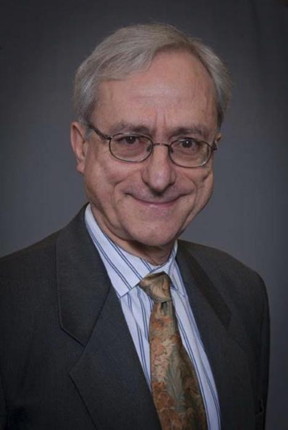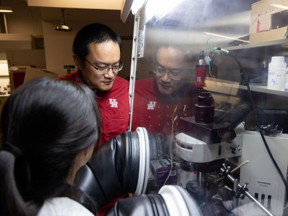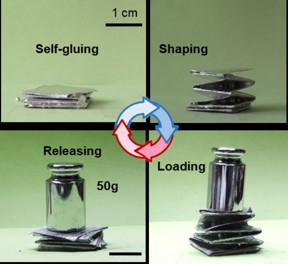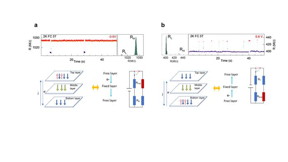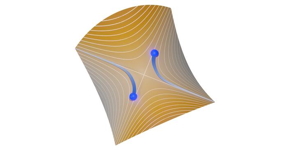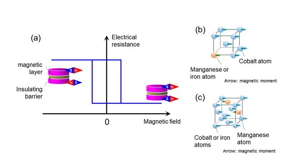Home > Press > Inverted perovskite solar cell breaks 25% efficiency record: Researchers improve cell efficiency using a combination of molecules to address different
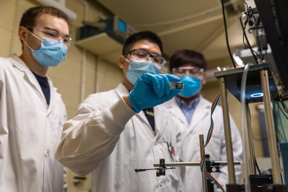 |
| Northwestern University researchers have raised the standards again for perovskite solar cells with a new development that helped the emerging technology hit new records for efficiency. CREDIT Please credit Sargent Lab/Northwestern University |
Abstract:
•Perovskite solar cells offer lower costs and efficiency comparable to silicon cells
•Using two molecules, researchers address multiple forms of efficiency loss
•Solution can work in tandem with other molecular interventions
Inverted perovskite solar cell breaks 25% efficiency record: Researchers improve cell efficiency using a combination of molecules to address different
Evanston, IL | Posted on November 17th, 2023
Northwestern University researchers have raised the standards again for perovskite solar cells with a new development that helped the emerging technology hit new records for efficiency.
The findings, published today (Nov. 17) in the journal Science, describe a dual-molecule solution to overcoming losses in efficiency as sunlight is converted to energy. By incorporating first, a molecule to address something called surface recombination, in which electrons are lost when they are trapped by defects — missing atoms on the surface, and a second molecule to disrupt recombination at the interface between layers, the team achieved a National Renewable Energy Lab (NREL) certified efficiency of 25.1% where earlier approaches reached efficiencies of just 24.09%.
“Perovskite solar technology is moving fast, and the emphasis of research and development is shifting from the bulk absorber to the interfaces,” said Northwestern professor Ted Sargent. “This is the critical point to further improve efficiency and stability and bring us closer to this promising route to ever-more-efficient solar harvesting.”
Sargent is the co-executive director of the Paula M. Trienens Institute for Sustainability and Energy (formerly ISEN) and a multidisciplinary researcher in materials chemistry and energy systems, with appointments in the department of chemistry in the Weinberg College of Arts and Sciences and the department of electrical and computer engineering in the McCormick School of Engineering.
Conventional solar cells are made of high-purity silicon wafers that are energy-intensive to produce and can only absorb a fixed range of the solar spectrum.
Perovskite materials whose size and composition can be adjusted to “tune” the wavelengths of light they absorb, making them a favorable and potentially lower-cost, high-efficiency emerging tandem technology.
Historically perovskite solar cells have been plagued by challenges to improve efficiency because of their relative instability. Over the past few years, advances from Sargent’s lab and others have brought the efficiency of perovskite solar cells to within the same range as what is achievable with silicon.
In the present research, rather than trying to help the cell absorb more sunlight, the team focused on the issue of maintaining and retaining generated electrons to increase efficiency. When the perovskite layer contacts the electron transport layer of the cell, electrons move from one to the other. But the electron can move back outward and fill, or “recombine” with holes that exist on the perovskite layer.
“Recombination at the interface is complex,” said first author Cheng Liu, a postdoctoral student in the Sargent lab, which is co-supervised by the Charles E. and Emma H. Morrison Professor of Chemistry Mercouri Kanatzidis. “It’s very difficult to use one type of molecule to address complex recombination and retain electrons, so we considered what combination of molecules we could use to more comprehensively solve the problem.”
Past research from Sargent’s team has found evidence that one molecule, PDAI2, does a good job at solving interface recombination. Next they needed to find a molecule that would work to repair surface defects and prevent electrons from recombining with them.
By finding the mechanism that would allow PDAI2 to work with a secondary molecule, the team narrowed in on sulfur, which could replace carbon groups — typically poor at preventing electrons from moving — to cover missing atoms and suppress recombination.
A recent paper by the same group published in Nature developed a coating for the substrate beneath the perovskite layer to help the cell work at a higher temperature for a longer period. This solution, according to Liu, can work in tandem with the findings within the Science paper.
While the team hopes their findings will encourage the larger scientific community to continue moving the work forward, they too will be working on follow-ups.
“We have to use a more flexible strategy to solve the complex interface problem,” Cheng said. “We can’t only use one kind of molecule, as people previously did. We use two molecules to solve two kinds of recombination, but we are sure there’s more kinds of defect-related recombination at the interface. We need to try to use more molecules to come together and make sure all molecules work together without destroying each other’s functions.”
####
For more information, please click here
Contacts:
Win Reynolds
Northwestern University
Copyright © Northwestern University
If you have a comment, please Contact us.
Issuers of news releases, not 7th Wave, Inc. or Nanotechnology Now, are solely responsible for the accuracy of the content.
| Related Links |
| Related News Press |
Perovskites
![]() Shedding light on unique conduction mechanisms in a new type of perovskite oxide November 17th, 2023
Shedding light on unique conduction mechanisms in a new type of perovskite oxide November 17th, 2023
News and information
![]() Night-time radiative warming using the atmosphere November 17th, 2023
Night-time radiative warming using the atmosphere November 17th, 2023
![]() A new kind of magnetism November 17th, 2023
A new kind of magnetism November 17th, 2023
Govt.-Legislation/Regulation/Funding/Policy
![]() Three-pronged approach discerns qualities of quantum spin liquids November 17th, 2023
Three-pronged approach discerns qualities of quantum spin liquids November 17th, 2023
![]() Nanoparticle quasicrystal constructed with DNA: The breakthrough opens the way for designing and building more complex structures November 3rd, 2023
Nanoparticle quasicrystal constructed with DNA: The breakthrough opens the way for designing and building more complex structures November 3rd, 2023
Possible Futures
![]() Shedding light on unique conduction mechanisms in a new type of perovskite oxide November 17th, 2023
Shedding light on unique conduction mechanisms in a new type of perovskite oxide November 17th, 2023
![]() Silver nanoparticles: guaranteeing antimicrobial safe-tea November 17th, 2023
Silver nanoparticles: guaranteeing antimicrobial safe-tea November 17th, 2023
![]() Three-pronged approach discerns qualities of quantum spin liquids November 17th, 2023
Three-pronged approach discerns qualities of quantum spin liquids November 17th, 2023
![]() Night-time radiative warming using the atmosphere November 17th, 2023
Night-time radiative warming using the atmosphere November 17th, 2023
Discoveries
![]() Night-time radiative warming using the atmosphere November 17th, 2023
Night-time radiative warming using the atmosphere November 17th, 2023
![]() A new kind of magnetism November 17th, 2023
A new kind of magnetism November 17th, 2023
Announcements
![]() Night-time radiative warming using the atmosphere November 17th, 2023
Night-time radiative warming using the atmosphere November 17th, 2023
![]() A new kind of magnetism November 17th, 2023
A new kind of magnetism November 17th, 2023
Interviews/Book Reviews/Essays/Reports/Podcasts/Journals/White papers/Posters
![]() Night-time radiative warming using the atmosphere November 17th, 2023
Night-time radiative warming using the atmosphere November 17th, 2023
![]() A new kind of magnetism November 17th, 2023
A new kind of magnetism November 17th, 2023
Military
![]() Nanoparticle quasicrystal constructed with DNA: The breakthrough opens the way for designing and building more complex structures November 3rd, 2023
Nanoparticle quasicrystal constructed with DNA: The breakthrough opens the way for designing and building more complex structures November 3rd, 2023
![]() Quantum powers researchers to see the unseen September 8th, 2023
Quantum powers researchers to see the unseen September 8th, 2023
![]() The picture of health: Virginia Tech researchers enhance bioimaging and sensing with quantum photonics June 30th, 2023
The picture of health: Virginia Tech researchers enhance bioimaging and sensing with quantum photonics June 30th, 2023
Energy
![]() Shedding light on unique conduction mechanisms in a new type of perovskite oxide November 17th, 2023
Shedding light on unique conduction mechanisms in a new type of perovskite oxide November 17th, 2023
![]() The efficient perovskite cells with a structured anti-reflective layer – another step towards commercialization on a wider scale October 6th, 2023
The efficient perovskite cells with a structured anti-reflective layer – another step towards commercialization on a wider scale October 6th, 2023
![]() Successful morphing of inorganic perovskites without damaging their functional properties October 6th, 2023
Successful morphing of inorganic perovskites without damaging their functional properties October 6th, 2023
![]() A non-covalent bonding experience: Scientists discover new structures for unique hybrid materials by altering their chemical bonds July 21st, 2023
A non-covalent bonding experience: Scientists discover new structures for unique hybrid materials by altering their chemical bonds July 21st, 2023
Solar/Photovoltaic
![]() Shedding light on unique conduction mechanisms in a new type of perovskite oxide November 17th, 2023
Shedding light on unique conduction mechanisms in a new type of perovskite oxide November 17th, 2023
![]() Charged “molecular beasts” the basis for new compounds: Researchers at Leipzig University use “aggressive” fragments of molecular ions for chemical synthesis November 3rd, 2023
Charged “molecular beasts” the basis for new compounds: Researchers at Leipzig University use “aggressive” fragments of molecular ions for chemical synthesis November 3rd, 2023
![]() The efficient perovskite cells with a structured anti-reflective layer – another step towards commercialization on a wider scale October 6th, 2023
The efficient perovskite cells with a structured anti-reflective layer – another step towards commercialization on a wider scale October 6th, 2023
![]() A universal HCl-assistant powder-to-powder strategy for preparing lead-free perovskites March 24th, 2023
A universal HCl-assistant powder-to-powder strategy for preparing lead-free perovskites March 24th, 2023
- SEO Powered Content & PR Distribution. Get Amplified Today.
- PlatoData.Network Vertical Generative Ai. Empower Yourself. Access Here.
- PlatoAiStream. Web3 Intelligence. Knowledge Amplified. Access Here.
- PlatoESG. Carbon, CleanTech, Energy, Environment, Solar, Waste Management. Access Here.
- PlatoHealth. Biotech and Clinical Trials Intelligence. Access Here.
- Source: http://www.nanotech-now.com/news.cgi?story_id=57421
- :has
- :is
- :not
- :where
- $UP
- 10
- 17
- 17th
- 21st
- 24
- 24th
- 25
- 27
- 30th
- 3rd
- 6th
- 7th
- 8th
- a
- According
- accuracy
- achievable
- achieved
- addition
- address
- Adjusted
- advances
- again
- All
- allow
- and
- Another
- appointments
- approach
- approaches
- ARE
- Army
- around
- Arts
- AS
- At
- atom
- author
- award
- back
- basis
- BE
- because
- been
- between
- breaks
- breakthrough
- bring
- brought
- Building
- but
- by
- called
- CAN
- carbon
- cell
- Cells
- Center
- Certified
- CGI
- challenges
- charge
- Charles
- chemical
- chemistry
- Cheng
- click
- closer
- cold
- College
- COM
- combination
- come
- comment
- Commerce
- commercialization
- community
- comparable
- complex
- composition
- computer
- Computer Engineering
- conducted
- considered
- contacts
- content
- continue
- converted
- Costs
- could
- cover
- credit
- critical
- damaging
- del
- Department
- describe
- Design
- designing
- develop
- developed
- Development
- DID
- different
- difficult
- Director
- discover
- Disrupt
- dna
- does
- e
- each
- Earlier
- efficiencies
- efficiency
- efficient
- electrons
- emerging
- Emerging Technology
- emphasis
- enables
- encourage
- end
- energy
- Engineering
- enhance
- EPIC
- Ether (ETH)
- evidence
- exist
- experience
- experiments
- facilities
- FAST
- favorable
- few
- fill
- films
- Find
- finding
- findings
- First
- fixed
- flexible
- focused
- For
- formerly
- forms
- Forward
- found
- Foundation
- from
- functional
- functions
- fundamental
- further
- futuristic
- generated
- gif
- good
- good job
- Group
- Group’s
- Harvesting
- Have
- Health
- help
- helped
- higher
- Hit
- Holes
- hopes
- http
- HTTPS
- Hybrid
- if
- improve
- in
- Inc.
- incorporating
- Increase
- information
- inorganic
- instability
- Institute
- Interface
- interfaces
- International
- international space station
- issue
- Job
- journal
- jpg
- July
- june
- just
- Kind
- lab
- larger
- laser
- layer
- layers
- lenses
- light
- links
- longer
- losses
- lost
- lower
- made
- maintaining
- make
- Making
- March
- materials
- mechanism
- mechanisms
- missing
- molecular
- molecule
- more
- move
- moving
- multidisciplinary
- multiple
- nanotechnology
- National
- National Science
- Nature
- Need
- needed
- net
- New
- news
- next
- nicholas
- Northwestern University
- nov
- November
- now
- NSF
- Nuance
- number
- october
- of
- offer
- Office
- on
- ONE
- only
- opens
- or
- Other
- Others
- over
- overcoming
- Paper
- part
- past
- People
- period
- PHP
- picture
- plagued
- plato
- Plato Data Intelligence
- PlatoData
- please
- Point
- poor
- Post
- posted
- potentially
- powers
- preparing
- present
- press
- Press Release
- prevent
- preventing
- previously
- probe
- Problem
- produce
- Professor
- Program
- promising
- published
- qualities
- Quantum
- raised
- range
- rather
- reached
- received
- receiving
- recent
- record
- records
- relative
- release
- Releases
- Renewable
- renewable energy
- repair
- replace
- research
- research and development
- researcher
- researchers
- resource
- responsible
- retain
- retaining
- return
- Route
- Said
- same
- Save
- School
- School of Engineering
- Science
- Science Foundation
- SCIENCES
- scientific
- scientists
- Search
- Second
- secondary
- see
- September
- setup
- Share
- Sherman
- SHIFTING
- Silicon
- Size
- So
- solar
- Solar cells
- solely
- solution
- SOLVE
- Solving
- something
- Space
- space station
- Spectrum
- speed
- Spin
- Stability
- stable
- standards
- start
- station
- Step
- Strategy
- structured
- structures
- Student
- Study
- submit
- sunlight
- support
- Supported
- sure
- Surface
- Sustainability
- Systems
- Tandem
- team
- tech
- technique
- Technology
- Ted
- than
- that
- The
- the world
- their
- Them
- they
- this
- to
- today
- together
- too
- tools
- towards
- transport
- trapped
- try
- trying
- two
- type
- typically
- under
- unique
- Universal
- university
- us
- use
- using
- very
- virginia
- was
- Wave
- wavelengths
- Way..
- we
- What
- What is
- when
- which
- whose
- wider
- will
- with
- within
- without
- Work
- work together
- working
- world
- would
- Yahoo
- years
- you
- zephyrnet










